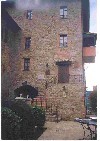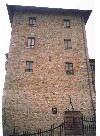The History of the Castle of Pietrafitta
 Located in the beautiful province of Perugia, the Castle of Pietrafitta rises gently to 276 meters above sea level on the sweet
slope of a hill near an ancient XI Century Benedictine monastery called "The Abbey of the Seven Friars". The first settlement were labourers who worked the earth of the area in the mid XII Century. A small number of houses were built on the side of the hill and actions were taken to decrease flooding and damage from landslides. Through the following decades more houses appeared as well as stores and handicraft shops. In order to satisfy the local residents, the bishop of Perugia erected the church of Saint Maria and provided the priest with living quarters to
take care of the church and provide a continued presence. Pietrafitta gains its name from the geological characteristics of the surrounding area which is made primarily of sandstone and hosts numerous caves. The extraction of the abundant stone and its working had a determining role in the birth of the locale name. Therefore, 'Petraficta' references the exact geological constitution on the hill where the castle arises. In the census of 1282, Peitrafitta Villa was classified as having a population equal to 48
families.
Located in the beautiful province of Perugia, the Castle of Pietrafitta rises gently to 276 meters above sea level on the sweet
slope of a hill near an ancient XI Century Benedictine monastery called "The Abbey of the Seven Friars". The first settlement were labourers who worked the earth of the area in the mid XII Century. A small number of houses were built on the side of the hill and actions were taken to decrease flooding and damage from landslides. Through the following decades more houses appeared as well as stores and handicraft shops. In order to satisfy the local residents, the bishop of Perugia erected the church of Saint Maria and provided the priest with living quarters to
take care of the church and provide a continued presence. Pietrafitta gains its name from the geological characteristics of the surrounding area which is made primarily of sandstone and hosts numerous caves. The extraction of the abundant stone and its working had a determining role in the birth of the locale name. Therefore, 'Petraficta' references the exact geological constitution on the hill where the castle arises. In the census of 1282, Peitrafitta Villa was classified as having a population equal to 48
families.
 Only around 1340, with the construction of its walls and powerful angular tower,
it could be raised to the title of "Castrum" (Castle). Just four years after the pestilence of 1348,
described by Boccaccio in the Decameron, in 1352 the "War of Bettona"
began between the military services of the archbishop Giovanni Visconti and the army of Guelf Perugino. Pietrafitta was attacked by the Ghibelline soldiers of Count Nolfo of Urbino. During the battle one of the many stones that were thrown from the tower struck
the exile (from Perugia) Filippo di Cecchino di Messer Vinciolo, vice commander of
guibelline troops. Filippo di Cecchino di Messer Vinciolo died at the base of the Tower of Pietrafitta.
In spite of the big difference of power, the
inhabitants and the few guards defended themselves with bravery, but at
the end of a bloody battle, they had to capitulate and the castle was
conquered. Count Nolfo, whose aim was to bring help to the besieged
Bettona, was forced to withdraw because the soldiers from Perugia had
closed all the ways.
The Italian abbeys, with the exception of those owned by the French, never caught up with the managerial autonomy and financial institutions and depended on the Papal States and the head bishops in their
area. In 1377, Pope Gregorio XI, asked by Santa Caterina from Siena,
brought the capital of Papal States from Avignon back to Rome, a plaque in memory of all events
was put into the castle. The castle then became used as a type of hospital for the ill and pilgrims.
Head of this institution was a prior, who holded this office for one
year and then he had to refer about his actions. The maintenance charges
were widely covered by donations made by religious people and with the
income derived from the estates called “beni dell’hospitale”.
During Medieval times, just a few people were able to read and write, so
it was quite common the "symbolism" in the paintings. Probably the
symbol of the "The Abbey of the Seven Friars" was a daisy; in fact
this symbol appears both on the base of the altar of the Abbey, on the
plaque in memory of the return of Papal
States from Avignone to Rome, and along the border
of the Fresco of Madonna inside the Castle.
With the restoration of the Tower of the Castle of Pietrafitta, the history of this territory refloursishes and provides a look at times passed, to when the 'Rinascimento' or 'Rebirth' period of art that provided much splendor in the art that was given to Italy.
Only around 1340, with the construction of its walls and powerful angular tower,
it could be raised to the title of "Castrum" (Castle). Just four years after the pestilence of 1348,
described by Boccaccio in the Decameron, in 1352 the "War of Bettona"
began between the military services of the archbishop Giovanni Visconti and the army of Guelf Perugino. Pietrafitta was attacked by the Ghibelline soldiers of Count Nolfo of Urbino. During the battle one of the many stones that were thrown from the tower struck
the exile (from Perugia) Filippo di Cecchino di Messer Vinciolo, vice commander of
guibelline troops. Filippo di Cecchino di Messer Vinciolo died at the base of the Tower of Pietrafitta.
In spite of the big difference of power, the
inhabitants and the few guards defended themselves with bravery, but at
the end of a bloody battle, they had to capitulate and the castle was
conquered. Count Nolfo, whose aim was to bring help to the besieged
Bettona, was forced to withdraw because the soldiers from Perugia had
closed all the ways.
The Italian abbeys, with the exception of those owned by the French, never caught up with the managerial autonomy and financial institutions and depended on the Papal States and the head bishops in their
area. In 1377, Pope Gregorio XI, asked by Santa Caterina from Siena,
brought the capital of Papal States from Avignon back to Rome, a plaque in memory of all events
was put into the castle. The castle then became used as a type of hospital for the ill and pilgrims.
Head of this institution was a prior, who holded this office for one
year and then he had to refer about his actions. The maintenance charges
were widely covered by donations made by religious people and with the
income derived from the estates called “beni dell’hospitale”.
During Medieval times, just a few people were able to read and write, so
it was quite common the "symbolism" in the paintings. Probably the
symbol of the "The Abbey of the Seven Friars" was a daisy; in fact
this symbol appears both on the base of the altar of the Abbey, on the
plaque in memory of the return of Papal
States from Avignone to Rome, and along the border
of the Fresco of Madonna inside the Castle.
With the restoration of the Tower of the Castle of Pietrafitta, the history of this territory refloursishes and provides a look at times passed, to when the 'Rinascimento' or 'Rebirth' period of art that provided much splendor in the art that was given to Italy.